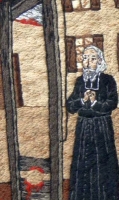
| 2 January |
• yesterday • tomorrow |
| Memorial of Saint Basil the Great and Saint Gregory Nazianzen, Bishops and Doctors of the Church |
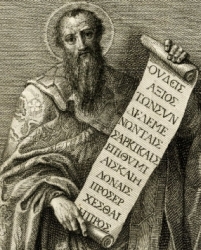
• Basil of Caesarea
• Father of Eastern Monasticism
• 2 January (Roman Catholic; Anglican Church; Lutheran Church)
• 15 January (Coptic Orthodox Church; Ethiopian Orthodox)
• 30 January (Eastern Orthodox; Byzantine Rite as part of the Synaxis of the Three Holy Hierarchs
• 14 June (Episcopal Church; Roman Catholic prior to 1969)
Born to the nobility, his was a pious family - his mother, father, and four of his nine siblings were canonized, including Saint Gregory of Nyssa. Grandson of Saint Macrina the Elder. As a youth Basil was noted for organizing famine relief, and for working in the kitchens himself, quite unusual for a young noble.
He studied in Constantinople and Athens with his friend Saint Gregory Nazianus. Ran a school of oratory and law in Caesarea. Basil was so successful, so sought after as a speaker, that he was tempted by pride. Fearful that it would overtake his piety, he sold all that he had, gave away the money, and became a priest and monk.
Founded monasteries and drew up rules for monks living in the desert; he is considered as key to the founding of eastern monasticism as Saint Benedict of Nursia was to the west. Bishop and Archbishop of Caesarea. Conducted Mass and preached to the crowds twice each day. Fought Arianism. Greek Doctor of the Church. Father of the Church.
329 at Caesarea, Asia Minor (modern Turkey)
1 January 379 at Caesarea, Asia Minor (modern Turkey) of natural causes
• Cappadocia
• hospital administrators
• monks
• reformers
• Russia
• carrying a scroll or book, referring to his influential writings
• supernatural fire, often with a dove nearby
O sinner, be not discouraged, but have recourse to Mary in all you necessities. Call her to your assistance, for such is the divine Will that she should help in every kind of necessity. - Saint Basil the Great
By the command of your only-begotten Son we communicate with the memory of your saints…by whose prayers and supplications have mercy upon us all, and deliver us for the sake of your holy name. - Liturgy of Saint Basil, 373AD
The bread which you use is the bread of the hungry; the garment hanging in your wardrobe is the garment of him who is naked; the shoes you do not wear are the shoes of the one who is barefoot; the acts of charity that you do not perform are so many injustices that you commit. - Saint Basil
Let us raise ourselves from our fall and not give up hope as long as we are free from sin. Jesus Christ came into this world to save sinners. 'Come, let us adore and prostrate ourselves and weep before him' (Psalm 95:6). The Word calls us to repentance, crying out: 'Come to me, all you who labor and are heavily burdened and I will refresh you' (Matthew 11:28). There is, then, a way to salvation if we are willing to follow it" - from a letter by Saint Basil the Great
Envy is a gnawing pain which springs from the success and prosperity of another; and this is the reason why the envious are never exempt from trouble and vexation. If an abundant harvest fills the granaries of a neighbor, if success crowns his efforts, the envious man is chagrined and sad. If one man can boast of prudence, talent, and eloquence; if another is rich, and is very liberal to the poor, if good works are praised by all around, the envious man is shocked and grieved. The envious, however, dare not speak; although envy makes them counterfeit gladness, their hearts are sore within. If you ask him what vexes him, he dare not tell the reason. It is not really the happiness of his friend that annoys him, neither is it his gaiety that makes him sad, nor is he sorry to see his friend prosper; but it is that he is persuaded that the prosperity of others is the cause of his misery. This is what the envious would be forced to acknowledge, if they spoke the truth sincerely; but because they dare not confess so shameful a sin, they, in secret, feed a sore which tortures them and eats away their rest. As the shadow ever accompanies the pedestrian when walking in the sun, so envy throws its shadow on those who are successful in the world. - Saint Basil, from "De Individia"
Thy fame has gone forth into all the earth, which has received thy word. Thereby thou hast taught the Faith; thou hast revealed the nature of created things; thou hast made a royal priesthood of the ordered life of men. Righteous Father Basil intercede with Christ our God that our souls may be saved. - troparion of Saint Basil the Great
Thou wast an unshaken foundation of the Church and didst give to all mortals an inviolate lordship which thou didst seal with thy doctrine, O righteous Basil, revealer of the mysteries of heaven. - kontakion of Saint Basil the Great
https://catholicsaints.info/saint-basil-the-great/

• Gregory of Nazianzus
• Grégoire de Nazianze
• The Christian Demosthenes
• The Theologian
• 2 January (Roman Catholic; Anglican)
• 25 January (optional memorial of his death; Orthodox; Armenian; Coptic; Syrian Orthodox)
• 3 January (Granada, Zaragoza and Jaca, Spain)
• 11 June (translation of relics to Rome, Italy)
• 30 January (translation of relics)
Son of Saint Gregory of Nazianzen the Elder and Saint Nonna. Brother of Saint Caesar Nazianzen, and Saint Gorgonius. Spent an wandering youth in search of learning. Friend of and fellow student with Saint Basil the Great. Monk at Basil's desert monastery.
Reluctant priest; he believed that he was unworthy, and that the responsibility would test his faith. He assisted his bishop father to prevent an Arian schism in the diocese. He opposed Arianism, and brought its heretical followers back to the fold. Bishop of Caesarea c.370, which put him in conflict with the Arian emperor Valens. The disputes led his friend Basil the Great, then archbishop, to reassign him to a small, out of the way posting at the edge of the archbishopric.
Bishop of Constantinople from 381 to 390, following the death of Valens. He hated the city, despised the violence and slander involved in these disputes, and feared being drawn into politics and corruption, but he worked to bring the Arians back to the faith; for his trouble he was slandered, insulted, beaten up, and a rival "bishop" tried to take over his diocese. Noted preacher on the Trinity. When it seemed that orthodox Christianity had been restored in the city, Gregory retired to live the rest of his days as a hermit. He wrote theological discourses and poetry, some of it religious, some of it autobiographical. Father of the Church. Doctor of the Church.
330 at Arianzus, Cappadocia, Asia Minor
25 January 390 of natural causes
• for harvests
• poets
• bishop with a book, codex or scroll
• censer
• man writing with dove nearby
• man writing with the hand of God over him
God accepts our desires as though they were of great value. He longs ardently for us to desire and love him. He accepts our petitions for benefits as though we were doing him a favor. His joy in giving is greater than ours in receiving. So let us not be apathetic in our asking, nor set too narrow bounds to our requests; nor ask for frivolous things unworthy of God's greatness. - Saint Gregory Nazianzen
Let us not esteem worldly prosperity or adversity as things real or of any moment, but let us live elsewhere, and raise all our attention to Heaven; esteeming sin as the only true evil, and nothing truly good, but virtue which unites us to God. - Saint Gregory Nazianzen
Basil and I were both in Athens. We had come, like streams of a river, from the same source in our native land, had separated from each other in pursuit of learning, and were now united again as if by plan, for God so arranged it. When, in the course of time, we acknowledged our friendship and recognized that our ambition was a life of true wisdom, we became everything to each other; we shared the same lodging, the same table, the same desires, the same goal. Our love for each other grew daily warmer and deeper. The same hope inspired us: the pursuit of learning. We seemed to be two bodies with a single spirit. Our single object and ambition was virtue, and a life of hope in the blessings that are to come. We followed the guidance of God's law and spurred each other on to virtue. If it is not too boastful to say, we found in each other a standard and rule for discerning right from wrong. Different men have different names, which they owe to their parents or to themselves, that is, to their own pursuits and achievements. But our great pursuit, the great name we wanted, was to be Christians, to be called Christians. - from a sermon by Saint Gregory Nazianzen
Today let us do honor to Christ's baptism and celebrate this feast in holiness. Be cleansed entirely and continue to be cleansed. Nothing gives such pleasure to God as the conversion and salvation of men, for whom his every word and every revelation exist. He wants you to become a living force for all mankind, lights shining in the world. You are to be radiant lights as you stand beside Christ, the great light, bathed in the glory of him who is the light of heaven. You are to enjoy more and more the pure and dazzling light of the Trinity, as now you have received - though not in its fullness - a ray of its splendor, proceeding from the one God, in Christ Jesus our Lord, to whom be glory and power for ever and ever. Amen. - from a sermon by Saint Gregory Nazianzen on the Feast of the Baptism of the Lord
https://catholicsaints.info/saint-gregory-of-nazianzen/

• Macarius of Alexandria
• Macarius the Alexandrian
• 2 January (Roman Catholic)
• 19 January (Orthodox; Armenian)
• 1 May (Coptic calendar)
• 13 July (Syrian Orthodox)
Successful merchant in fruits, candies, and pastries in Alexandria, Egypt. Converting to Christianity, Macarius gave up his business in 335 to become a monk and hermit in the Thebaid, Upper Egypt. For a while he lived near and was a friend of Saint Anthony the Abbot. Macarius was a poet, healer, and friend to wild animals. He was exiled by heretic Arians with Saint Macarius the Elder and other monks to an island in the Nile because of his orthodoxy, but he was later allowed to return. In later life he travelled to Lower Egypt, and was ordained, and lived in a desert cell with other monks. He wrote a constitution for the monastery at Nitria named after him, and some of its rules were adopted by Saint Jerome for his monastery.
Amazing stories grew up his practice of severe austerities, some of which reached the proportion of legend.
For seven years he lived on raw vegetables dipped in water with a few crumbs of bread, moistened with drops of oil on feast days.
He once spent 20 days and 20 nights without sleep, burnt by the sun in the day, frozen by bitter desert cold cold at night. "My mind dried up because of lack of sleep, and I had a kind of delirium," the hermit admitted. "So I gave in to nature and returned to my cell."
Trying to get further from the world, and closer to God, Macarius moved to the desert of Nitria in Lower Egypt in 373. The journey was through a harsh land, at when Macarius was at the end of his strength, the devil appeared and asked, "Why not ask God for the food and strength to continue your journey?" Macarius answered, "The Lord is my strength and glory. Do not tempt a servant of God." The devil then gave him a vision of a camel laden with food. Macarius was about to eat, but suspected a trap, and so prayed over the camel; it vanished.
He spent six months naked in the marshes, beset constantly by viscious blood-sucking flies and mosquitoes, in the hope of destroying his last bit of sexual desire. The terrible conditions and attacking insects left him so deformed that when he returned to the monks, they could recognize him only by his voice.
A young brother once offered Macarius some very fine grapes. The old fruit dealer was about to eat when he decided to sent them to a brother who was ill. This brother passed them to one he considered more in need; that one did the same, and on and on until the grapes made the rounds of all the cells and returned to Macarius.
Macarius returned to Skete and began to work on his worst vice - his love of travel. The devil appeared and suggested Macarius go to Rome and chase out the demons there. Torn between travelling for such a good cause, but wishing to fight his vice, Macarius filled a large basket with sand, put it on his back, and set out. When someone offered to help him, he said, "Leave me alone! I am punishing my tormenter. He wishes to lead me, old and weak as I am, on a distant and vain voyage." He then returned to his cell, body broken with fatigue, but cured of his temptation.
In old age Macarius journeyed to a monastery where 1,400 hermits lived under the rigid rule of Saint Pachomius. Macarius was refused admittance. "You are too old to survive the great rigor we have here," Pachomius told him. "One should be trained in it from childhood, or else one cannot stand it. Your health would fail and you would curse us for harming you." Macarius then stood at the abbey gate for seven days and nights - without sleep, without food, without saying a word. Finally, the monks relented and he let him in. Macarius stood in a corner of the monastery in complete silence for all of Lent, living on a few cabbage leaves each Sunday "more to avoid ostentation, than from any real need." The monks became so jealous of this new brother that they took their complaint to Pachomius, who asked God for illumination. When he learned that the old man was Macarius, he went to him and said, "My brother, I thank you for the lesson you have given my sons. It will prevent their boasting about their modest mortifications. You have edified us sufficiently. Return to your own monastery, and pray for us each day."
early 4th century at Alexandria, Egypt
c.401 in Alexandria, Egypt of natural causes
• confectioners
• cooks
• pastry chefs
• flies
• flies stinging a desert hermit
• hermit with lamp
• hermit with lantern
• hermit leaning on a crutch in the form of a tau staff while conversing with a skull
• monk with a bag of sand on the shoulders
• monk with a lantern
• monk with grapes
• monk with wild animals around him
https://catholicsaints.info/saint-macarius-the-younger/
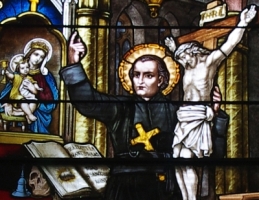
• Apostle of Rome
• Caspar Bufalo
• Caspar del Bufalo
• Gaspare del Bufalo
• Hammer of Italian Freemasonry
• Kasper del Bufalo
• Martello dei Carbonari
Son of Antonio del Bufalo, a chef to Prince Altieri, and Annunziata Quartieroni. As an infant he suffered from an eye condition that threatened to blind him; he was cured in 1788 following prayers for the intervention of Saint Francis Xavier. Studied at the Collegium Romanum from age twelve, and considered becoming a Jesuit. President of the newly instituted catechetical school of Santa Maria del Pianto at age 19. Ordained on 31 July 1808. On 23 October 1808 he, with his friends Father Bonanni, Father Santelli and Father Gonnelli, founded the nocturnal Oratory of Saint Mary in Vinci, Italy. On 8 December 1808 he helped Father Albertini found the Confraternity of the Precious Blood in San Nicola Arcella, Italy.
Following Rome's fall to the French in 1809, the Papal States were suppressed on 17 May, Pope Pius VII was deported on 6 July, and priests were ordered to take an oath of loyalty to Napoleon. Gaspare refused, and on 13 June 1810 was exiled for five years with many other priests first to Piacenza, Italy, and then Bologna, Italy. On 13 September 1811 he refused a second time to take the oath; he was lodged in San Giovanni prison, then the prison of Imola, Italy and then the fortress in Imola. A third refusal led to his transfer to the fortress in Lugo, Italy on 16 May 1813. Following a fourth refusal, on 10 December 1813, he was sentenced to exile in Corsica. While waiting for transport in Florence, Italy he received an invitation to join the Evangelical Workers, a group of priests who preach home missions. Though it was questionable at the time that he could help them, Gaspare enthusiastically joined. Less than a month later, Murat restored liberty to all priests who had been arrested or exiled for refusing to take the oath. In February 1814, Gaspare returned to Rome, Italy after four years of captivity, and in December he began preaching missions.
In July of 1815, Gaspare renounced his position as canon of Saint Mark's in order to concentrate on missions. He helped formally start the Missioners of the Precious Blood (C.P.P.S.) in 1815 at Giano dell'Umbria, Italy, a congregation devoted to preaching and to bring the sacraments back to war-torn Italy; it was under the patronage of Francis Xavier. Many houses were established in the next few years, and on 27 December 1817 Gaspare was elected First Promotor and Missionary of the Missioners. Many opposed his good work, and spoke against him to Pope Leo XII and Pope Pius VIII, but after they spoke to him personally, both approved of his work.
In 1821 Pope Pius VII assigned Gaspare to clean up provinces overrun with highway bandits, and to open six mission houses in the area; Gaspare spent the next five years in the pulpit, call for reform. In February 1826 he was chosen papal nuncio to Brazil. Gaspare begged to be released from the assignment so he could continue to preach, but was forced to spend eight months in the position. He then returned to his Congregation's motherhouse of San Felice in October 1826, and resumed preaching and tending to the Missionaries's houses for his last ten years.
6 January 1786 at Rome, Italy
• 28 December 1837 of cholera
• buried at Santa Maria in Trivio, Italy
12 June 1954 by Pope Pius XII
https://catholicsaints.info/saint-gaspare-bufalo/
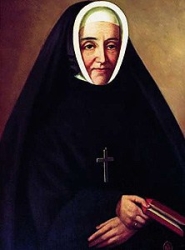
• Esther Blondin
• Sister Marie-Anne
• Marie-Anne Blondin
18 April (Canada)
Born to a pious, French-Canadian farm family, the daughter of Jean Baptiste Blondin and Marie Rose Limoges. Illiterate into adulthood, as were the other members of her family and most of her acquaintances. Domestic servant for a village merchant, and then in the convent of the Sisters of the Congregation of Notre Dame, where she learned to read and write. Entered as a novice in the Sisters, but ill health forced her to leave.
Parochial school teacher at Vaudreuil, Quebec in 1833; she was later named directress of the school, which was renamed the Blondin Academy. There she realized the reason for the widespread illiteracy in the area: girls could only be taught by women, boys only by men; parishes that could not afford two schools simply had none. In 1848 she sought permission to form a congregation that would teach boys and girls in the same school. It was a radical notion in its day, but had government support, and the bishop authorized a test site. The Congregation of the Sisters of Saint Anne was founded in Vaudreuil on 8 September 1850 with Esther as first superior, taking the name in religion of Marie-Anne.
The community grew, and the motherhouse transferred to Saint Jacques de l'Achigan in 1853. There the new chaplain, Father Louis Adolphe Marechal, abused his position, meddled in the financial and spiritual life of the Congregation, and generally sabotaged the work of Mother Marie Anne. Marechel succeeded in having her removed from her position in the Congregation.
Directress at Saint Genevieve Convent, but she continued to be harassed by Marechal. Accused of mismanagement, she was recalled to the Motherhouse in 1858, and was prohibited for her remaining 32 years from an administrative position; the sisters were ordered not to refer to her as "Mother". Realizing that any fight she could make would only damage the Congregation, she accepted her lot, and worked in the laundry, the ironing room, and other menial positions. Elected several times as superior of the Congregation, she was forbidden to accept, and never tried. Her humility and resignation paid off as the Congregation continued to grow, and universal education became the norm.
18 April 1809 in Terrebonne, Quebec, Canada as Esther Blondin
2 January 1890 at Lachine, Quebec, Canada of natural causes
29 April 2001 by Pope John Paul II
Model of a humble and hidden life, Marie-Anne Blondin found interior strength by contemplating the cross, showing us that the life of intimacy with Christ is the surest way to give fruits mysteriously and fulfill the mission willed by God. - Pope John Paul II at the beatification of Blessed Maria
Lord, You gave to Blessed Marie Anne Blondin a heart impassioned for your glory and You called her to serve with tenderness the young, the poor and the sick. You gave her hope in the most difficult moments of her life and You led her to deep serenity. Be praised, Lord, for your humble servant, Blessed Marie Anne Blondin. Through her intercession grant us the favour that we ask of You with confidence. Amen. - prayer for obtaining a favour
https://catholicsaints.info/blessed-maria-anna-blondin/
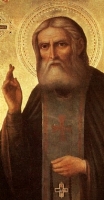
Prokhor Moshnin
19 July (translation of relics)
Son of a builder, he had a middle-class upbringing. Monk at Sarov in 1777, taking the name Seraphim. Studious as a boy, he was able to apply himself there as the monks of Sarov spent much of the day studying Scripture and the early Church writings. Severely ill and bed-ridden from 1780 to 1783, Seraphim continued his studies, and received repeated apparitions of the Virgin Mary. Ordained in 1793, he celebrated Mass daily, which was unusual at the time.
In 1794 he became a hermit in the forest near the Sarov monastery. In 1804 he was severely beaten by thieves, and left for dead; he dragged himself to the monastery, spent five months in recovery, and spent the rest of his life stooped and requiring a cane to walk. He lived for a while atop a pillar, then in a walled up cell. Offered the abbacy of Sarov in 1807, but declined, and lived the next three years without speaking.
In 1810 his health had deteriorated to the point that he could no longer live in the woods. He returned to the Sarov abbey, and lived as a hermit within its walls. In 1832 he received a vision from the Virgin Mary that told him to return to the world and give others the benefit of his wisdom. He attracted followers and students, became known as a healer, and was called by the honourific starets, Russian for spiritual teacher. Many of his teachings have been reprinted in the West, and Pope John Paul II referred to him in the book Threshold of Hope.
1759 at Kursk, Russia as Prokhor Moshnin
2 January 1833 at the monsatery at Sarov, Russia of natural causes
1903 by the Russian Orthodox Church
From thy youth up thou hast loved Christ, O blessed Saint, and aflame with the desire to work for Him alone thou hast contended in unceasing prayer and laboured in the wilderness: and gaining by compunction of heart the love of Christ, thou hast appeared as the chosen of the Mother of God. Therefore we cry to thee: Save us by thy prayers, O Father Seraphim. - troparion of Saint Seraphim of Sarov
Having left the beauty of the world and what is corrupt in it, O Saint, thou didst settle in Sarov Monastery. And having lived there an angelic life, thou wast for many the way to salvation. Wherefore Christ has glorified thee, O Father Seraphim,and has enriched thee with the gift of healing and miracles. And so we cry to thee: Rejoice, O Seraphim our righteous Father. - kontakion of Saint Seraphim of Sarov
https://catholicsaints.info/saint-seraphim-of-sarov/
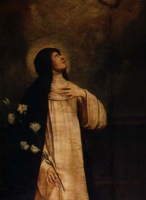
Stephanie de Quinzanis
Born to pious parents; her father became a Dominican tertiary while Stephana was very young. She was taught her catechism by the stigmatic Blessed Matthew Carrieri who lived at the nearby Dominican convent; though she was too small to understand, he told her that she was to be his spiritual heiress. She began receiving visions of Dominican saints from age seven, at which point she made personal vows of poverty, chastity and obedience.
Carrieri died when Stephana was 14; soon after he appeared to her in a vision, and she received the stigmata.
Dominican tertiary at Soncino, Italy at age 15. Devoted to caring for the poor and sick. She founded a community of Third Order sisters in Soncino, and served as its first abbess. Her counsel was sought by many including Saint Angela Merici, Blessed Augustine of Biella, and Blessed Osanna of Mantua.
Though she had no formal theological training, she could discuss mystical theology at the most profound level. She could read the hearts and minds of the people around her, and had the gift of prophesy and healing. She lived in a nearly continuous fast, and inflicted severe penances on herself. Stephana accurately predicted the date of her own death.
1457 at Soncino, Italy
2 January 1530 of at Soncino, Italy of natural causes
14 December 1740 by Pope Benedict XIV (cultus confirmed)
God of all consolation, you made Blessed Stephana a sharer in the passion of Christ. With the help of her prayers and by following her example may we be conformed to the image of your Son, who lives and reigns with you and the Holy Spirit, one God, for ever and ever. - Prayer from the General Calendar of the Order of Preachers
https://catholicsaints.info/blessed-stephana-de-quinzanis/
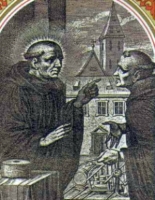
Adalard, Adalhard, Adelhard, Adalardus, Adelardus, Alard, Alardus, Adalardo
Grandson of Charles Martel; nephew of King Pepin the Short; first cousin of Charlemagne. Grew up in the royal court, and was an advisor to Louis le Debonnaire. Adalard gave up the court life in 773 to become a Benedictine monk at Corbie Abbey. Gardener in the monastery. Studied under Blessed Alcuin. Abbot. Advisor to Charlemagne, chaplain, and tutor to prince Bernard who later became king of Naples, Italy. Adelard was exiled to the island of Héri (modern Noirmoutier-en-l'Île, France) in 817 after being accused of supporting Bernard's revolt against Emperor Louis the Debonair, Charlemagne's successor. He actually enjoyed the peace that came with the isolation, but was later recalled. With Abbot Wala of Corbie, he founded Corvey Abbey in Saxony. Relics reported to have healed the deaf, the mute, and the paralyzed.
c.752
• 2 January 827 at Corbie Abbey, Picardy, France following a brief illness
• relics translated in 1026
1026 by Pope John XIX
• against fever
• against typhoid
• gardeners
• abbot digging a garden with his crown lying nearby
• being crowned with thorns by an angel
• giving alms or food to the poor
• kneeling before a crucifix
• overcoming a dragon by displaying IHS
https://catholicsaints.info/saint-adelard-of-corbie/
Silvestro di Troina
Born to the local nobility, as a young man he became a twelfth-century monk in the Basilian monastery of Saint Michael the Archangel in Troina, Sicily, Italy, where he became known for his charity. Lived briefly at the monastery of San Filippo di Fragalà near Frazzanò, Italy. Ordained a priest by Pope Adrian VI in Rome, Italy c.1155. Soon after he was chosen served as abbot of his house. In later life he resigned his position to live as a prayerful hermit in a cell in a wooded area near the monastery and next to the oratory of Saint Barthomomew.
Some miracle stories have attached to him including discovering that a beggar he helped was Jesus. He is reported to have travelled to the shrine of Saint Agatha on her feast day in Etna, on foot, 40 miles each way, and finished the trip and his devotions in an hour. Healed the son of King William I of Sicily by praying for the boy and making the sign of the cross over him. A procession of his relics and prayers for his intercession is credited for ending a plague outbreak in Sicily in 1575.
late 11th or early 12th century in Troina, Sicily, Italy
• 2 January 1164 in Troina, Sicily, Italy of natural causes
• after miracles were reported at his grave, a church dedicated to him was built over it in 1625
by Pope Julius III in the mid-16th century (cultus confirmation)
• Limina, Sicily, Italy
• Troina, Sicily, Italy
https://catholicsaints.info/blessed-sylvester-of-troina/

Aspasia, Aspasie, Coupaïa, Koupaia, Pompaïa, Pompée, Pompey
• 26 July on some calendars
• last Sunday in July (Tréguier, Saint Pompée, Langoat, diocese of Saint-Brieuc, France)
Born a princess, the daughter of King Eusebius and Saint Landouenne, and learned her faith at her mother's knee. She immigrated from the British Isles to Brittany in France c.500 to marry King Hoel I, and become queen of Armorique in Brittany. The couple and their court were forced into exile in England in 509 by invading Frisians; King Hoel re-captured his kingdom in 513. Mother of seven children including Saint Tugdual, Saint Sève, Saint Lunaire, and King Hoël II of Brittany. Queen Koupaïa and her son Tugdual and daughter Sève returned to Amorica in 545 after the death of King Hoel. Tugdual founded the monastery of Tréguier, and Koupaïa spent her remaining days nearby, living as a prayerful hermitess; the church of Langoat, France was built on the site of her home.
latter 5th century in the British Isles
• c.545 of natural causes in Brittany, France
• interred in the church of Saint Pompey in Langoat, France
https://catholicsaints.info/saint-koupaia/

• Defendente of Thebes
• Defendens...
• 22 September as one of the Martyrs of the Theban Legion
• 14 September (Romano di Lombardia, Italy)
• 4th Sunday in August (Torre Canavese, Italy)
• last Sunday in August (Montemarzo di Asti, Italy)
Christian soldier in the Theban Legion of the imperial Roman army. Martyred by emperor Maximian for refusing to sacrifice to pagan gods prior to a battle.
beheaded c.286 along the Rhone river in Agauno (modern Marseille, France)
• against fire
• against wolves
• 16 towns in Italy
imperial Roman soldier holding a palm of martyrdom
https://catholicsaints.info/saint-defendente-the-theban/
Agathon
Macarius was a high civic official, a Vicarius Praefecti, in Rome, Italy. He retired from public life to live as a prayerful, penitent hermit at Chierno, Italy, which was later renamed Sacerno, which is now part of Calderara di Reno. Some records list him as an abbot, but we have no information on what monastery he may have been attached to.
Rome, Italy
• mid-5th century in Chierno (modern Sacerno district of Calderara di Reno), Bologna, Italy of natural causes
• buried at the church of Saint Helena in Chierno
• relics transferred to the Basilica of Saint Xystus in Piacenza, Italy where an altar was dedicated to him
• relics transferred to Siena, Italy by Archbishop Galter in 1249
for good weather (a tradition in the region of Bologna, Italy)
https://catholicsaints.info/saint-macarius-of-rome/

• Marcolinus of Forli
• Marcolino Amannai da Forli
• Mark the Mute
• Marcolino...
Joined the Dominicans in Forli, Emilia, Italy when he was just a boy, and became known for his simple life, his love of quiet and solitude, and his service to the poor and children. Had a great devotion to the Blessed Virgin Mary, and carried a picture of her with him at all times.
1317 in Forli, Emilia, Italy
• in February 1397 in Forli, Emilia, Italy of natural causes
• buried in the cathedral in Forli
9 May 1750 by Pope Benedict XIV (cultus confirmation)
https://catholicsaints.info/blessed-marcolinus-amanni/
Son of Gundebertus and Magneldis. Studied at the convent school of Saint-Etienne, Cahors, France. His family arranged a marriage to one Hebrildis, but he refused which led to a beating by his father, and Maximus leaving home to live as a hermit. While on a bear hunt, his father found Maximus in his hermitage, took him prisoner, hauled him home, and announced that the wedding was on again. Maximus escaped and fled to the monastery of Saint-Martial near Limoges, France, and then to the monastery of Saint-Mauritius in Vienne, France where he became a monk and lived the rest of his life. Priest. Abbot of Saint-Mauritius.
c.563 near Cahors, France
2 January 625 in Vienne, France of natural causes
https://catholicsaints.info/saint-maximus-of-vienne/
Friend of Saint Cybri. Spiritual teacher of Saint Elaeth the King. His memory is perpetuated by the name of the island of Ynys-Seiriol.
6th century Wales
We hymn thee, O Father Seiriol, for thou didst turn the Welsh wilderness into a fertile vineyard for the Lord. By this our intercession, O Saint, we implore thee to pray to Christ our God that our labours may be blessed and our souls may be saved. - troparion of Saint Seiriol
Thy radiant memory illuminates the ages, O holy Seiriol, defying the darkness of apostacy and error. May the day once more dawn when all Wales will confess the Faith of our Fathers and keep festival to honour thee. - kontakion of Saint Seiriol
https://catholicsaints.info/saint-seiriol/
• Viance of Aquitaine
• Vincentian...
Born to a family of serfs, Viance was orphaned at the age of ten. He was befriend by the son of the duke of Aquitaine, and studied with him at the church school at Cahors, but the duke ordered that Viance be returned to his position as a serf, and he was assigned to oversee the stable hands. He was regularly abused by the duke for his piety and charity to those even poorer than himself, but was eventaully allowed to pursue the life of a prayerful hermit. Saint-Viance, France is named in his honour.
Anjou (in modern France)
c.673 of natural causes
https://catholicsaints.info/saint-viance-of-anjou/
• Munchin of Luimneach
• Munchin of Luimnich
• Munchin the Wise
• Little Monk
• Maincin, Mainchin, Mainquino, Manchen, Munchino
First bishop of Limerick (Luimneach), occupying the see in the 7th century. A prince gave him the island, possibly in exchange for Munchin giving up a claim to the throne. Established the school at Mungret and served as abbot to its 1,500 monks.
County Clare, Ireland
• Limerick, Ireland, city of
• Limerick, Ireland, diocese of
https://catholicsaints.info/saint-munchin-of-limerick/
Teodor, Teodoro
Sixth-century bishop of Marseille, Gaul (in modern France). For trying to establish clerical discipline and control of his clergy, he ran into opposition from King Childebert and King Guntram, and was sometimes imprisoned and was exiled three times. Attended the synod of Mâcon in 585. Received letters from Pope Saint Gregory the Great about the proper way to convert Jews by convincing them of the faith instead of forcibly baptizing them as some priests were doing.
594 of natural causes
https://catholicsaints.info/saint-theodore-of-marseille/
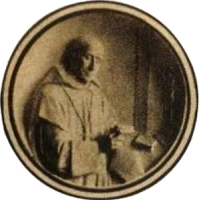
• Airaldo di Saint-Jean-de-Maurienne
• Ayraldus of Maurienne
Son of William II, Count of Burgundy. Carthusian monk at Portes, diocese of Belley, France. Prior of his house. Bishop of Maurienne in the Savoy from 1132 to 1156, a position he had to be ordered to accept.
1160 at Maurienne, France of natural causes
8 January 1863 by Pope Pius IX (cultus confirmed)
https://catholicsaints.info/saint-airaldus-of-maurienne/
• Odino Truchseß
• Otto, Otteno, Ottino
Born to the German nobility, related to the counts of Rajasthan and Waldburg. Premonstratensian monk. Canon of Mönchsrot Abbey in Rot at Memmingen, Germany. Abbot of the house for 42 years during which time the house grew to 200 monks and 40 nuns. His spiritual student went out to found Mercedarian canonries in Wilten, Weißenau, Steingaden, Obermarchtal, Kaiserslauter and Adelberg.
1100
1182 at Mönchsrot Abbey of natural causes
https://catholicsaints.info/blessed-odino-of-rot/
• Aspasius of Eauze
• Aspasius of Meaux
• Aspasius of Melun
• Aspais, Aspasio
Bishop of Eauze (modern Auch), France. Took part in the Councils of Orleans in 533, 541 and 549. Held a provincial council in 551. Venerated in Meaux and Melin, France.
• 560 of natural causes
• relics enshrined in the church of Saint Aspasius in Melun, France
• against abscesses
• against headaches
• Melun, France
https://catholicsaints.info/saint-aspasius-of-auch/
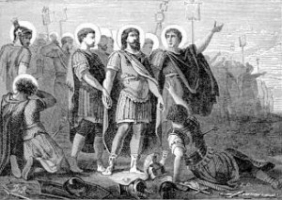
Soldier. Member of the Theban Legion. To escape the persecution of Emperor Maximian, he fled from his unit to the Piedmont region of Italy, but was caught, convicted of being a Christian, and executed. Martyr.
• c.288 in Piedmont, Italy
• relics enshrined in a stone coffin in a church in Fossano, Italy on 2 January 1427
• relics later transferred to the cathedral of Narni, Italy
https://catholicsaints.info/saint-sebastian-of-agaunum/

Soldier. Member of the Theban Legion. To escape the persecution of Emperor Maximian, he fled from his unit to the Piedmont region of Italy, but was caught, convicted of being a Christian, and executed. Martyr.
• c.288 in Piedmont, Italy
• relics enshrined in a stone coffin in a church in Fossano, Italy on 2 January 1427
• relics later transferred to the cathedral of Narni, Italy
https://catholicsaints.info/saint-alverius-of-agaunum/

Vilhelm, William
Priest in the diocese of Angers, France. Martyred in the persecutions of the French Revolution.
26 August 1709 at Thouarcé, Maine-et-Loire, France
2 January 1794 at Angers, France
19 February 1984 by Pope John Paul II at Rome, Italy
https://catholicsaints.info/blessed-guillaume-repin/
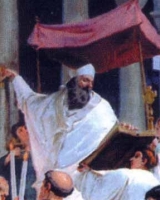
• John Camillus
• John the Good
• John Bonus
Archbishop of Milan, Italy, the first to live in the city for 80 years, his predecessors being in exile due to Arian Lombard invasion. Fought Arianism and Monothelitism.
c.660 of natural causes
https://catholicsaints.info/saint-john-camillus-the-good/
Detmar, Thietmar
Benedictine monk, possibly at double monastery in Prague, Bohemia (in modern Czech Republic). Chosen first bishop of Prague on 23 March 973 where he served for the rest of his life. Ordained Saint Adalbert of Prague to the priesthood.
10th century Saxony (in modern Germany)
2 January 982 in Prague, Bohemia (in modern Czech Republic)
https://catholicsaints.info/saint-dietmar-of-prague/
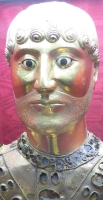
Baudenius, Baudime
Priest. Late 3rd and early 4th century missionary to the Auvergne region of Gaul (in modern France) where he worked with Saint Nectarius.
https://catholicsaints.info/saint-baudimius-of-auvergne/
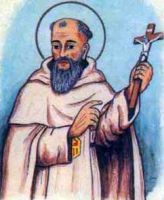
Mercedarian friar in Valladolid, Spain. Noted for his in-depth study of the early Church fathers and of prophecy, and his skill at passing this wisdom along to his Mercedarian brothers.
Valladolid, Spain of natural causes
https://catholicsaints.info/blessed-guillermo-de-loarte/
Hortolane, Hortulana, Ortulana
Married to Count Faverone of Sciffi. Mother of Saint Agnes of Assisi and Saint Clare of Assisi. Pilgrim to assorted holy sites in Europe, and to the Holy Land. Widow. Poor Clare nun in San Damiano Abbey in Assisi, Italy with her daughter Clare.
c.1238 Assisi, Italy
https://catholicsaints.info/saint-hortolana-of-assisi/
Priest of the diocese of Angers, France. Martyred in the persecutions of the French Revolution.
4 February 1744 in Saint-Maurille de Chalonnes-sur-Loire, Maine-et-Loire, France
martyred on 2 January 1794 at Angers, Maine-et-Loire, France
19 February 1984 by Pope John Paul II at Rome, Italy
https://catholicsaints.info/blessed-laurent-batard/
Bladulph, Bladulf, Blidulfo, Bladulfo
Monk at Bobbio, Italy. Spiritual student of Saint Columbanus. Denounced the heresy of King Arioald of the Lombards. Worked to reform the royal court and the region.
630 of natural causes
https://catholicsaints.info/saint-blidulf-of-bobbio/
Bishop of Vienne, France in 199. Pope Victor consulted him about the proper dates for Easter. Led his diocese during the persecutions of Emperor Alexander Severus.
Greece
c.239
https://catholicsaints.info/saint-paracodus-of-vienne/
Asclipe
Priest. Bishop of Limoges, France. Founded a Benedictine monastery in Limoges and restored the cloister in Bourges, France.
9th century
https://catholicsaints.info/saint-asclepius-of-limoges/
Viance, Viants
Spiritual student of Saint Menelaus. Hermit in the diocese of Tulle (modern Auvergne, France).
c.730 of natural causes
https://catholicsaints.info/saint-vincentian-of-tulle/
Isidore of Egypt
Fourth century bishop of Nitria (modern AL Barnuji) in the Egyptian desert. Welcomed Saint Jerome to Egypt.
https://catholicsaints.info/saint-isidore-of-nitria/
Isidonus, Isiridonus, Siridon, Siridion
Bishop of Zaragoza, Spain. Martyred, possibly by Arians.
https://catholicsaints.info/saint-isidore-of-antioch/
A deaf–mute man known for his piety and ascetic lifestyle. No other information about him has survived.
https://catholicsaints.info/saint-mark-the-mute/
Theodora
Mother of Saint Cosmas and Saint Damian.
250 of natural causes
https://catholicsaints.info/saint-theodota/
Martyr.
stoned to death, date and location unknown
https://catholicsaints.info/saint-theopistus/
There were many martyrs who suffered in the persecutions of Diocletian for refusing to surrender the holy books. Though we know these atrocities occured, we do not know the names of the saints, and we honour them as a group.
c.303 in Rome, Italy
https://catholicsaints.info/many-martyrs-who-suffered-in-rome/
A group of Christian soldiers martyred together for their faith. We know the names of five - Albanus, Macarius, Possessor, Starus and Stratonicus.
Greece
Antioch (modern Antakya, Turkey)
https://catholicsaints.info/martyrs-of-antioch-2-january/
The Christians of Britain appear to have escaped unharmed in the earlier persecutions which afflicted the Church; but the cruel edicts of Diocletian were enforced in every corner of the empire, and the faithful inhabitants of this land, whether native Britons or Roman colonists, were called upon to furnish their full number of holy Martyrs and Confessors. The names of few are on record; but the British historian, Saint Gildas, after relating the martyrdom of Saint Alban, tells us that many others were seized, some put to the most unheard-of tortures, and others immediately executed, while not a few hid themselves in forests and deserts and the caves of the earth, where they endured a prolonged death until God called them to their reward. The same writer attributes it to the subsequent invasion of the English, then a pagan people, that the recollection of the places, sanctified by these martyrdoms, has been lost, and so little honour paid to their memory. It may be added that, according to one tradition, a thousand of these Christians were overtaken in their flight near Lichfield, and cruelly massacred, and that the name of Lichfield, or Field of the Dead, is derived from them.
https://catholicsaints.info/menology-of-england-and-wales-many-martyrs-of-britain-c-300/
A group of Christians martyred together for their faith. We know the names of three - Auriga, Claudia and Rutile.
Ethiopia
https://catholicsaints.info/martyrs-of-ethiopia/
A group of Christians martyred together for their faith. We know the names of two - Stephen and Vitalis.
Jerusalem
https://catholicsaints.info/martyrs-of-jerusalem/
Many Christians suffered at Lichfield (aka Lyke-field, meaning field of dead bodies), England in the persecutions of Diocletian. Though we know these atrocities occured, we do not know the names of the saints, and we honour them as a group.
304 at Lichfield, England
https://catholicsaints.info/martyrs-of-lichfield/
A group of Christians who died together for their faith in the persecutions of Diocletian. No details about them have survived.
on the site of church of Madonna di Campagna, Piacenza, Italy
https://catholicsaints.info/martyrs-of-piacenza/
Missionaries, sent by Saint Fronto of Périgueux to the area of Puy, France. Tortured and martyred by local pagans. We know the names - Frontasius, Severinus, Severian and Silanus.
• beheaded in Puy (modern Puy-en-Velay), France
• buried together in the church of Notre Dame, Puy-en-Velay by Saint Fronto, their bodies laid out to form a cross
https://catholicsaints.info/martyrs-of-puy/
Group of Christians martyred together, date unknown. We know the names of seven - Acutus, Artaxus, Eugenda, Maximianus, Timothy, Tobias and Vitus - but very little else.
3rd or 4th century at Syrmium, Pannonia (modern Sremska Mitrovica, Serbia)
https://catholicsaints.info/martyrs-of-syrmium/
Three brothers, all Christians, all soldiers in the imperial Roman army, and all three martyred in the persecutions of emperor Licinius Licinianus. We know their names - Argeus, Marcellinus and Narcissus - but little else.
320 at Tomi, Exinius Pontus, Moesia (modern Constanta, Romania)
https://catholicsaints.info/martyrs-of-tomi/
CatholicSaints.Info Portable Edition